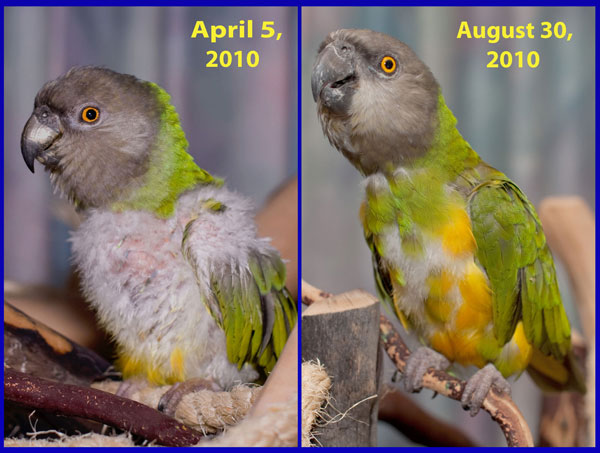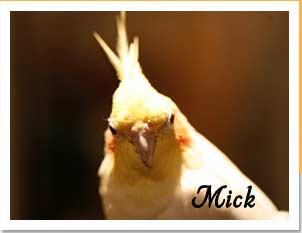Grover's Story
Story and pictures by Vincent J. Hrovat

During her stay in a Mickaboo foster home, Grover has slowly but surely been growing her feathers back.
As anyone who’s cared for a bird with a plucking disorder knows, the potential causes of such a disorder are many. The primary causes of chronic and destructive plucking behavior include poor diet, food allergies, boredom, stress, fear, zinc or lead poisoning, environmental toxins, infection, skin disorder, and hypothyroid disorder. To further complicate things, plucking can become a habit that is hard for a bird to break, or it can cause skin discomfort which stimulates further plucking. These secondary causes can mean that the plucking habit will continue after the primary causes have been remedied.
Frequently, Mickaboo has access to very little information about a surrendered bird’s past. Such was the case with Grover the Senegal parrot. We knew that she came from a recently foreclosed home where she’d been kept in a tiny, dirty cage and probably never handled. And we knew that she’d been plucking: Grover had bare spots across her chest, wings and back where she’d pulled out all of her contour feathers and much of her down. Her tail feathers were chewed down to short nubs.
Without knowing the possible causes of a bird’s plucking, some elements of their treatment path may be subject to trial and error, but this treatment should always include all of the familiar elements of good avian husbandry. With recent intakes like Grover, where little is known about what kind of baggage they have, the best approach to caring for them is with a hierarchy-of-needs similar to Maslow’s pyramid. In other words, first things first!
In Grover’s case, we found that her most basic needs, food and shelter, were being met soon after she came into foster care, and that she was not obviously ill. She was eating on her own– seed mix and a little bit of veggies -- and was reasonably comfortable inside of her new cage, though she was scared to move around much. As she settled in, we began to challenge Grover with a wider variety of healthier foods and more ambient contact with people. At first, she was afraid to come out of her cage and instead sat in the back, fixated on a small mirror toy that had come with her. The mirror bird must have seemed like her only friend at the time.
Grover continued to pluck during her first few weeks in foster care. When we saw her doing this we’d call out to her to get her attention, and she’d stop for a while. She seemed to become increasingly curious about why we were calling her, so she would climb to the front of her cage and watch us. We were able to leverage that curiosity to finally get Grover to come out of her cage and visit with us. At first she would only step onto a hand that was covered with a white towel, so we always kept one near her cage. Once she was out, she wanted to get back into her cage quickly so, to keep her in her comfort zone, we kept these sessions short.
Now that she was socializing with us, Grover was ready to ascend to the next level of her needs pyramid. With a little positive reinforcement, she began to spend progressively longer periods of time away from her cage. Since she had accepted her foster dad into her flock, she no longer clung next to her mirror all day and she didn’t mind when we finally took it away altogether. Grover quickly learned how to climb a ladder and, thanks to target training, to turn herself around in a little circle. She became tolerant, if not fond, of mist baths, and she received one every day. She learned to forage for her food, and her eyes would light up when she got her favorite, carrots and Brussels sprouts, served on a hanging kabob. When given her first pine cone and a little stimulation, Grover learned how to play, which was a milestone for this once-scared little bird.
As Grover progressed, we saw less and less of her self-destructive behavior as she became increasingly responsive to our attempts to redirect this behavior. Grover’s 19th day in foster care was the last time that anyone saw her plucking. We don’t know whether it was her diet, the mist baths, the overall enrichment that she was receiving or something else that brought upon this change. The root cause is not important, as long as the effects are positive.
Since then, Grover has been climbing her needs pyramid on her own! Her destructive plucking behavior has been replaced by careful and diligent preening as her feathers slowly grow back in. Her wings are almost fully covered in green now; her tail has grown back completely, and her belly and chest are over halfway there. She’s beginning to show her characteristic orange vest, and more people are able to properly identify her as a Senegal parrot.
Grover has continued to improve on her diet and social skills, and she has learned to play on her own, to keep herself active and satisfied with minimal human intervention. Pine cones are still her favorite toy and hanging carrot and Brussels sprout kabobs still her favorite food. A naturally agile and curious bird, Grover loves climbing around her cage and playpen, looking for hidden toys or the occasional carrot or bud of millet. She is still shy around people, especially strangers, but she is no longer scared of them. With continued behavioral work, Grover’s quality of life should remain high and her plucking behavior will, hopefully, not recur.
Like so many rescued birds, Grover has not always had an easy life, but a few months of good, Mickaboo-quality care have helped to make her a happier, healthier, and more beautiful bird. Today Grover is ready to make her next step towards a good future, with an adoption into a safe and loving home. If you are interested in meeting Grover and perhaps making her a part of your family, please contact Mickaboo’s Poicephalus coordinator. 
Instead of plucking her feathers, Grover now directs her energy towards chewable toys such as this pine cone.

